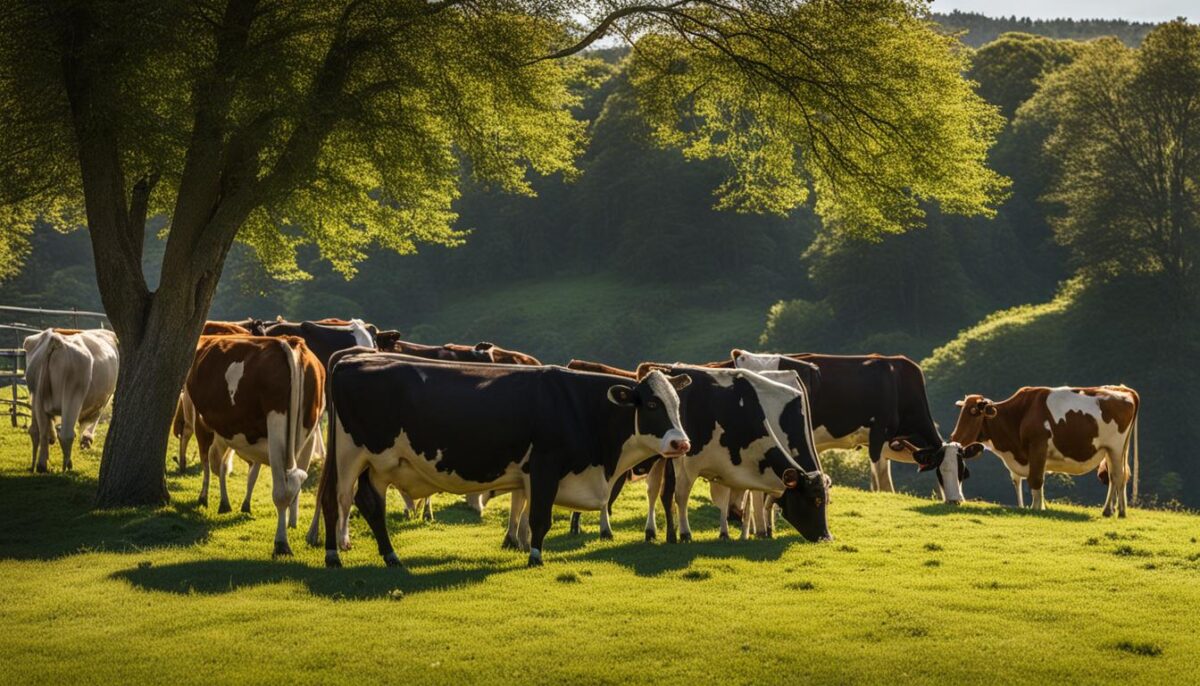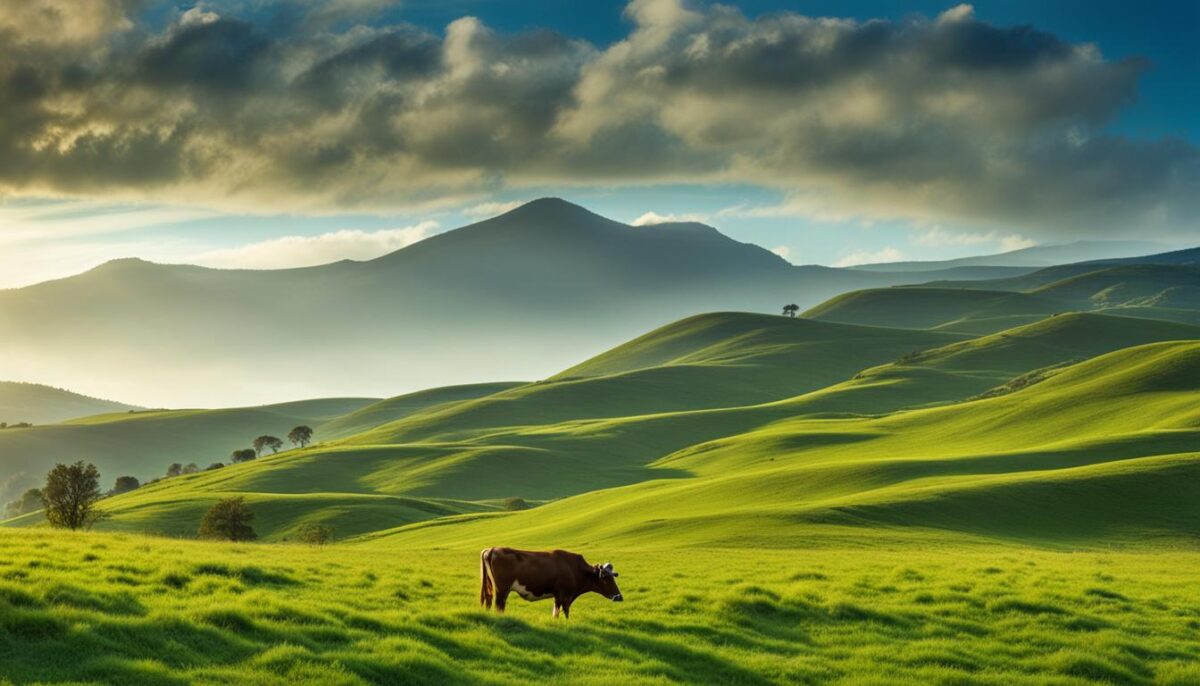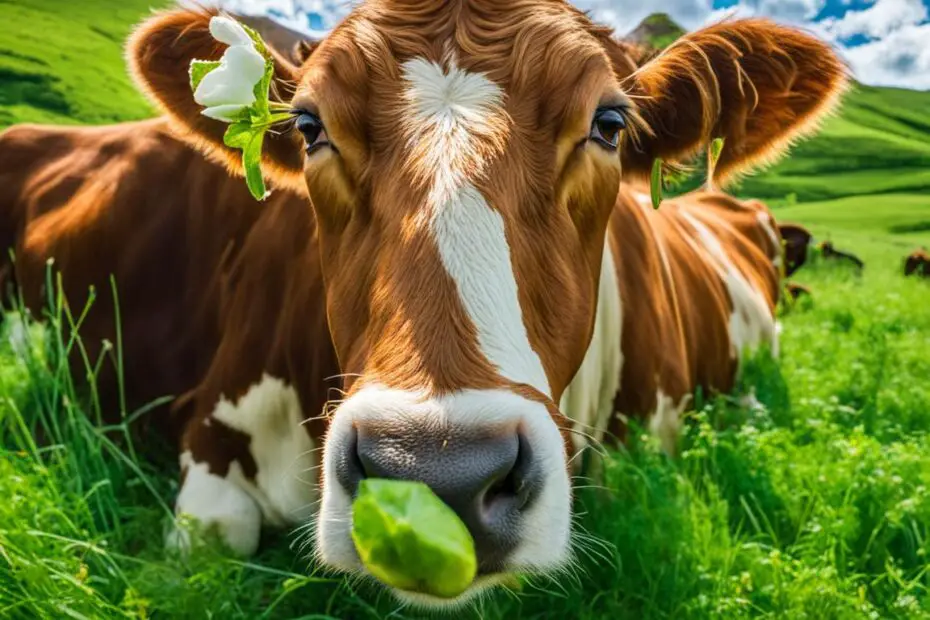Cows are curious creatures with peculiar eating habits, leaving us wondering about the truth behind the infamous question – do cows eat rocks? In this article, we will dive into the fascinating world of cow feeding habits and explore the reality behind this intriguing phenomenon.
Key Takeaways:
- Cows are herbivores and primarily consume grass and other plant materials as part of their diet.
- While rocks are not typically a part of a cow’s diet, some cows have been observed eating rocks due to factors like mineral deficiencies or curiosity.
- Rocks ingested by cows can aid in the mechanical grinding process in their rumen, assisting in the breakdown of plant materials.
- Ingesting large or sharp-edged rocks can pose health risks to cows, causing damage to their teeth, gums, and digestive tract.
- Proper management of grazing areas, providing a well-balanced diet, and regular veterinary care are crucial in preventing cows from consuming rocks and maintaining their overall well-being.
The Cow’s Diet: A Closer Look
Cows, as herbivores, have a specific diet that mainly consists of grass and other plant materials. They spend most of their time grazing on pastures and feeding on hay, silage, and occasionally grain. While rocks are not a typical part of a cow’s diet, there have been instances where cows have been observed consuming them.
These unusual cases of cows eating rocks fall under a phenomenon called pica, which can occur in animals for various reasons such as mineral deficiencies, boredom, or curiosity. However, it’s important to note that the frequency of cows consuming rocks is relatively rare and not a common occurrence.
Understanding the cow’s digestive system helps shed light on the role of rocks in their diet. Cows have a unique digestive process that involves a large fermentation chamber called the rumen. Within the rumen, microorganisms break down cellulose from plant materials. In some cases, rocks that are ingested can aid in the mechanical grinding process, assisting with the breakdown of fibrous plant materials in the cow’s rumen.
Table: Cow’s Diet Overview
| Component | Percentage |
|---|---|
| Grass | 70% |
| Hay | 20% |
| Silage | 5% |
| Grain (occasionally) | 5% |
While the occasional consumption of small rocks may not cause significant harm to cows, the ingestion of larger or sharp-edged rocks can pose health risks. These rocks can cause damage to the cow’s teeth, gums, and digestive tract, resulting in discomfort, decreased feed intake, and potential injuries. It is crucial for farmers and owners to prevent cows from accessing rocks and other foreign objects to ensure their overall well-being.
The Phenomenon of Cows Eating Rocks
Despite rocks not being a natural part of a cow’s diet, there have been reports of cows eating rocks. This peculiar behavior is known as pica and can occur in animals due to various reasons, such as mineral deficiencies, boredom, or curiosity. However, the frequency of cows eating rocks is relatively rare and not a common occurrence.
While the exact cause of pica in cows is not fully understood, it is believed that mineral deficiencies play a significant role. Cows require a balanced diet to meet their nutritional needs, including a sufficient supply of minerals like calcium, phosphorus, and magnesium. Inadequacies in these essential minerals can lead to abnormal eating behaviors, such as consuming rocks.
Additionally, cows may engage in pica out of boredom or curiosity. In a natural grazing environment, cows spend a significant amount of time grazing and foraging for food. However, if cows are confined to limited grazing areas or provided with insufficient stimulation, they may resort to unconventional behaviors like eating rocks.
The Impact of Pica on Cows
The consumption of rocks can have adverse effects on a cow’s health. While small rocks may pass through the digestive system without causing significant harm, larger or sharp-edged rocks can pose serious risks. Ingesting these rocks can lead to damage to the cow’s teeth, gums, and digestive tract, resulting in discomfort, decreased feed intake, and potential injuries.
To ensure the well-being of cows and prevent them from consuming rocks, it is crucial to implement management practices that minimize the risk. This includes providing a well-balanced and nutritious diet, regular monitoring of grazing areas to remove rocks and debris, and ensuring access to a stimulating environment that prevents boredom and curiosity-driven pica. By taking these measures, we can safeguard the health and welfare of cows and promote their optimal feeding habits.

| Causes of Pica in Cows | Effects of Rock Consumption in Cows |
|---|---|
| Mineral deficiencies | Damage to teeth, gums, and digestive tract |
| Boredom | Discomfort |
| Curiosity | Decreased feed intake |
Cow Digestion and the Role of Rocks
One of the fascinating aspects of cow physiology is their unique digestive system. Cows are ruminant animals, which means they have a specialized four-chambered stomach designed to break down and extract nutrients from fibrous plant materials. The rumen, the largest chamber, acts as a fermentation vat where microorganisms help break down complex carbohydrates like cellulose. This process allows cows to efficiently digest and extract energy from grass and other plant materials.
So where do rocks come into play? While rocks are not a natural part of a cow’s diet, there have been instances where cows have been observed consuming them. While it may seem strange, rocks can actually aid in the mechanical grinding process in the cow’s rumen, assisting in the breakdown of plant materials. The rough surfaces of the rocks act as an abrasive, helping to break down tough plant fibers and facilitate the release of nutrients.
“The ingestion of rocks by cows is not a common occurrence, but it can happen. The role of rocks in the cow’s digestion process is purely mechanical, helping to break down plant materials. However, it’s important to note that cows should not have access to large or sharp-edged rocks, as they can cause harm to the cow’s teeth, gums, and digestive tract.”
While rocks may serve a functional role in cow digestion, it’s essential to prevent cows from ingesting rocks that could potentially cause harm. Providing a well-balanced diet that meets their nutritional needs, along with proper pasture management, can help minimize the risk of cows consuming rocks. Regular monitoring of grazing areas to remove any rocks or debris is also crucial for ensuring the cow’s well-being and digestive health.
The Potential Dangers of Eating Rocks
While cows typically do not consume rocks as part of their natural diet, the occasional ingestion of small rocks can occur. However, larger or sharp-edged rocks can pose serious health risks to cows. These risks include the potential for dental damage, injuries to the digestive tract, and discomfort that can lead to decreased feed intake. It is crucial for farmers and livestock caretakers to take proactive measures in order to prevent cows from accessing and ingesting rocks.
When cows consume rocks, the sharp edges can cause abrasions and cuts in their mouth, gums, and throat. Additionally, larger rocks can become lodged in the cow’s digestive tract, leading to blockages and potential injuries. This can result in severe pain and stress for the animal, and in some cases, may require surgical intervention to remove the foreign objects.
To ensure the overall well-being of cows, it is important to implement proper grazing and feeding management practices. Regular monitoring of grazing areas should be conducted to remove any rocks or debris that may be present. Providing a well-balanced diet and nutritional supplements can help prevent mineral deficiencies that may lead to pica, a condition where cows crave and consume non-nutritive substances like rocks.
| Signs and Symptoms of Rock Ingestion in Cows | Risk Factors |
|---|---|
|
|
| Table: Signs and Symptoms of Rock Ingestion in Cows and Risk Factors | |
By prioritizing the prevention of rock ingestion in cows, farmers can minimize the potential dangers and ensure the health and well-being of their livestock. A combination of proper feeding practices, regular veterinary care, and vigilant monitoring of grazing areas can go a long way in protecting cows from the risks associated with consuming rocks.
Managing Cow Grazing and Feeding to Prevent Rock Consumption
Proper management of grazing areas and feeding practices is crucial to minimize the risk of cows consuming rocks. Providing cows with a well-balanced diet and nutritional supplements can help prevent mineral deficiencies that may lead to pica, the unusual habit of eating non-food items. Regular monitoring of grazing areas and removing any rocks or debris can also reduce the likelihood of cows ingesting rocks.
One effective method to manage cow grazing behavior is rotational grazing. This involves dividing the pasture into smaller sections and allowing cows to graze in one area while other sections rest and regrow. By implementing a rotational grazing system, cows have access to fresh and nutritious grass, reducing the chances of them seeking alternative food sources like rocks.
In addition to managing grazing areas, providing cows with appropriate feed and nutrition is essential. Ensuring that their diet consists of high-quality forage, such as hay or silage, can help meet their nutritional needs and reduce the likelihood of them searching for non-food items. It is important to consult with a veterinarian or animal nutritionist to determine the appropriate feed ration for cows based on their specific requirements.
Regular veterinary care is also crucial in preventing abnormal eating behaviors in cows. Veterinarians can assess the overall health of the cows, identify any underlying health issues that may contribute to pica, and provide appropriate treatment or dietary adjustments. By maintaining good animal husbandry practices, such as proper fencing and pasture management, and working closely with a veterinarian, farmers can effectively manage cow grazing and feeding habits, reducing the risk of rock consumption and ensuring the well-being of their cattle.
The Role of Veterinary Care and Animal Husbandry Practices
Regular veterinary care and proper animal husbandry practices are crucial for ensuring the health and well-being of cows. Not only do veterinarians play a vital role in providing guidance on proper nutrition and monitoring the cow’s diet, but they can also address any underlying health issues that may contribute to unusual eating behaviors.
Implementing good animal husbandry practices is equally important in preventing cows from accessing rocks and other potentially harmful substances. Proper fencing and pasture management can help create a safe environment for the cows, reducing the risk of them consuming rocks unintentionally.
Table: Key Factors of Veterinary Care and Animal Husbandry Practices
| Veterinary Care | Animal Husbandry Practices |
|---|---|
| – Nutrition guidance | – Proper fencing |
| – Diet monitoring | – Pasture management |
| – Addressing health issues | – Monitoring grazing areas |
Veterinarians can also provide valuable insights into the unique feeding habits and behaviors of cows. Through scientific research and studies, they contribute to our understanding of cow nutrition and help prevent abnormalities such as the consumption of rocks. By studying the complex relationship between cows and their diet, researchers can identify patterns, potential risks, and appropriate feeding practices to ensure the optimal health and nutrition of cows.

Ultimately, through a combination of regular veterinary care, proper nutrition, and good animal husbandry practices, we can maintain the overall health and well-being of cows. By preventing cow rock consumption and providing them with a balanced and appropriate diet, we ensure that they thrive in their natural grazing habitat.
Scientific Research and Studies on Cow Feeding Habits
Understanding the feeding habits of cows is a topic that has captured the interest of researchers and scientists. Through scientific research and studies, valuable insights have been gained into the complex relationship between cows and their diet. These studies not only shed light on the normal eating patterns of cows but also uncover unusual behaviors, such as the consumption of rocks. By examining cow feeding habits from a scientific perspective, we can better understand their nutritional needs and prevent abnormalities in their diet.
One significant area of research is focused on cow nutrition. Scientists have investigated the nutritional requirements of cows to ensure their diets are properly balanced. By analyzing the composition of various feed sources and studying their effects on cow health and performance, researchers can recommend optimal feeding strategies. These studies help farmers and ranchers make informed decisions when it comes to providing cows with the right nutrients to support their growth, reproduction, and overall well-being.
“It is fascinating to see how the nutritional needs of cows play a crucial role in their overall health,” said Dr. Jane Williams, a renowned animal nutritionist. “Through scientific research, we have been able to identify the essential nutrients cows require and develop feeding programs that meet those needs. This knowledge has been instrumental in improving the productivity and welfare of cows.”
Another area of study is focused on the grazing behavior of cows. Researchers have observed and analyzed the grazing patterns of cows to gain insights into their natural feeding instincts. They have studied factors such as forage availability, plant preferences, and grazing efficiency. Understanding how cows interact with their grazing environment helps farmers and ranchers implement effective management practices that ensure cows have access to high-quality forage while preventing the consumption of harmful substances like rocks.
| Study | Research Findings |
|---|---|
| Nutritional Composition of Cow Diets | Identified the essential nutrients required for cow health and performance, including protein, carbohydrates, vitamins, and minerals. |
| Grazing Behavior Observations | Revealed the preferred forage plants of cows and their grazing patterns, helping farmers optimize pasture management. |
| Mechanical Grinding Efficiency | Investigated the role of rocks in the rumen for plant material breakdown, highlighting their importance in the cow’s digestive process. |
Scientific research and studies on cow feeding habits continue to provide valuable insights into the dietary needs and behaviors of cows. By building upon this knowledge, we can enhance the health and welfare of cows, optimize their productivity, and ensure sustainable farming practices. Ongoing research in this field will further our understanding of cow nutrition and lead to the development of innovative feeding strategies for the benefit of both cows and farmers alike.
Conclusion
While it is uncommon for cows to intentionally eat rocks, the phenomenon of pica can occur in some individuals. Cows are herbivores and primarily consume grass and other plant materials as part of their diet. However, there have been instances where cows have been observed consuming rocks.
To prevent cow rock consumption and ensure their overall health, proper nutrition, veterinary care, and good animal husbandry practices are crucial. Providing the right balance of nutrients and preventing mineral deficiencies can help mitigate the risk of pica. Regular monitoring of grazing areas and removing any rocks or debris can also minimize the likelihood of cows ingesting rocks.
Understanding the unique feeding habits and behaviors of cows is essential in maintaining their well-being. By implementing appropriate feeding practices, conducting scientific research, and seeking guidance from veterinarians, we can contribute to the optimal health and nutrition of cows, reducing the occurrence of unusual eating habits like rock consumption.
FAQ
Do cows actually eat rocks?
While rocks are not a typical part of a cow’s diet, there have been instances where cows have been observed eating rocks.
Why do cows eat rocks?
The peculiar behavior of cows eating rocks, known as pica, can occur due to reasons such as mineral deficiencies, boredom, or curiosity.
Is it common for cows to eat rocks?
The frequency of cows eating rocks is relatively rare and not a common occurrence.
Can rocks be beneficial to a cow’s digestion?
Rocks, if ingested, can potentially assist in the mechanical grinding process in the cow’s rumen and aid in the breakdown of plant materials.
Are there any risks associated with cows consuming rocks?
Ingesting larger or sharp-edged rocks can pose health risks, including damage to the cow’s teeth, gums, and digestive tract.
How can the risk of cows eating rocks be minimized?
Proper management of grazing areas, feeding practices, and regular monitoring of grazing areas to remove rocks can help prevent cows from ingesting rocks.
What role does veterinary care and animal husbandry practices play in preventing cows from eating rocks?
Regular veterinary care and good animal husbandry practices, such as proper fencing and pasture management, can help prevent cows from accessing rocks and other potential harmful substances.
Has there been any scientific research conducted on cow feeding habits?
Yes, scientific research and studies have been conducted to gain a better understanding of cow feeding habits and behaviors.
Are cows known for any other unusual eating habits?
While it is uncommon for cows to intentionally eat rocks, the phenomenon of pica can occur in some individuals.


